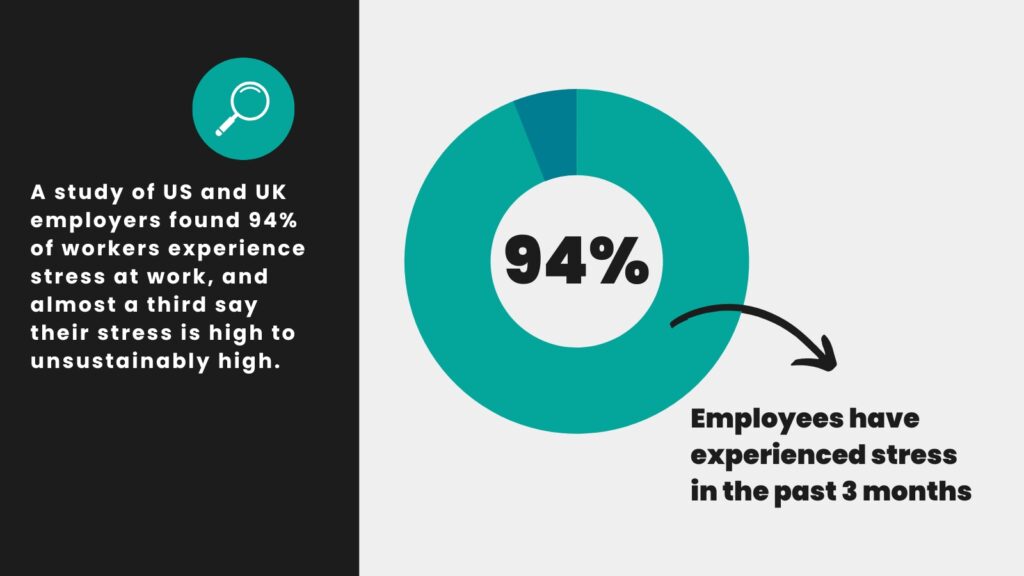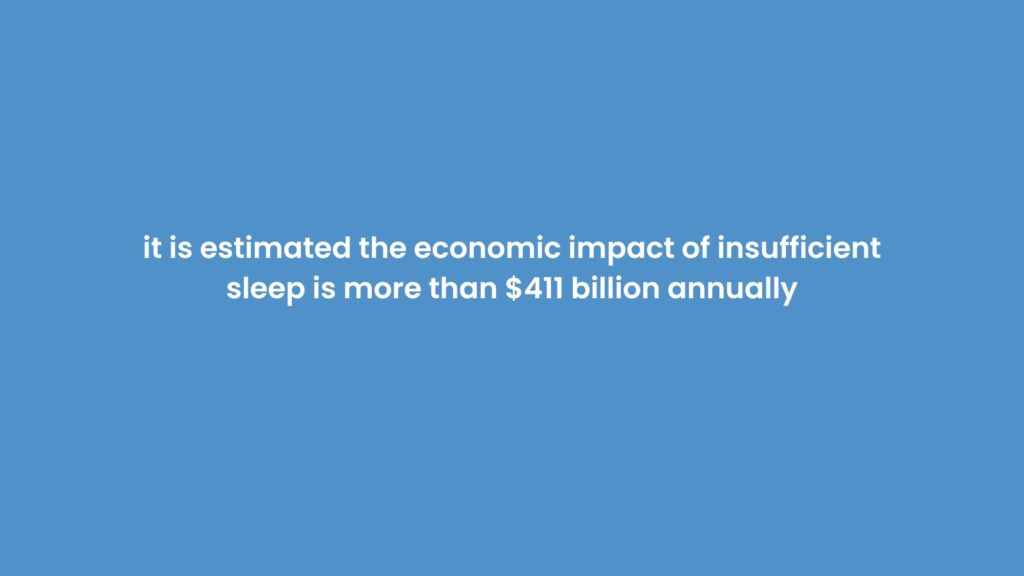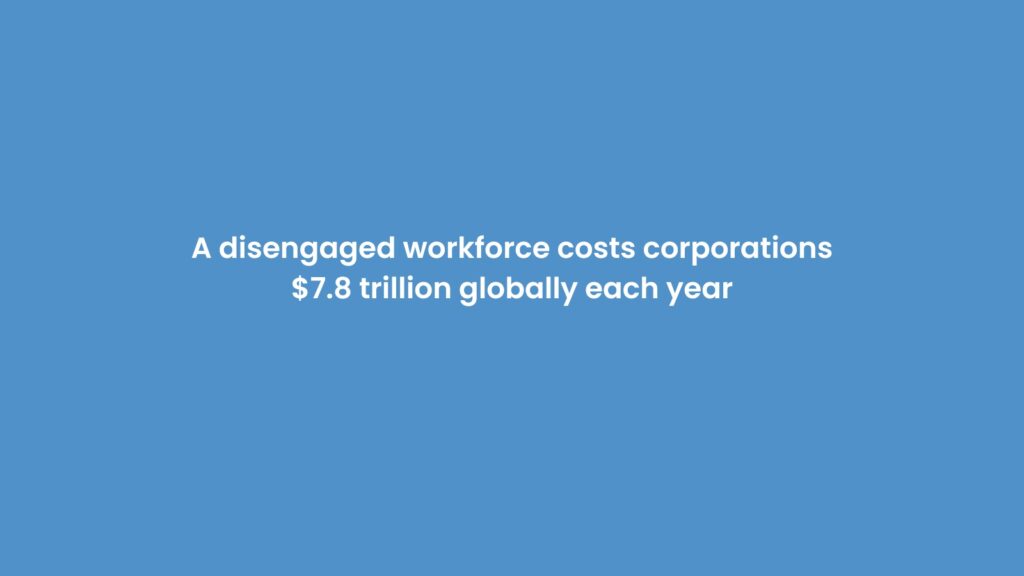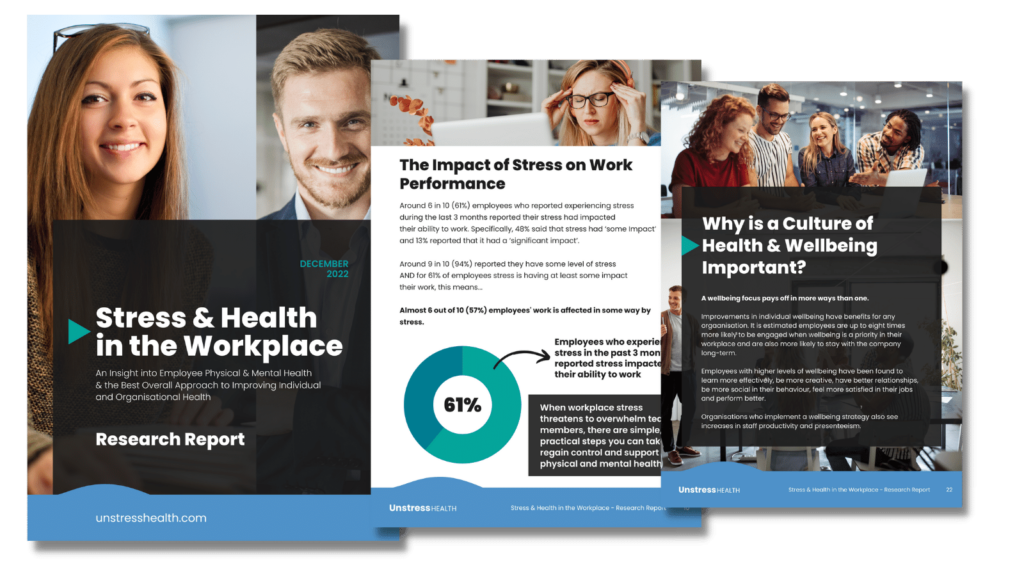A healthy workforce is an engaged workforce
Stress and health affect the way individuals show up and perform at work. This impacts the collective health of an organisation, impacting it’s overall performance and success.
The available evidence suggests return on wellbeing investments are high – driven predominantly through reduction in presenteeism, resulting in the increase of performance and productivity.
Summary:
- More than half of employees feel their mental health could be better, with those under the age of 35 most affected.
- Employee’s sleep is imperative for the overall health of the organisation.
- 57% of people report their work is impacted by their stress levels.
- The burnout rate has increased, and young managers and leaders are disproportionately affected.
- Stress management in the workplace is key to employee health and wellbeing and corporate culture is vital for business success.
- It is estimated untreated mental health conditions will cost Australian businesses $10.9 billion per year.
Stress in the modern workplace and its impact on organisations
The workplace is a source of significant stress for people working in the modern corporate environment. Long working hours, conflict with colleagues and managers, job security, and a heavy workload contribute to significant employee burden.
In addition, employees are now having to navigate a culture of urgency, with the expectation of always being on and available, with little time for rest or disconnection.
Work-related stress has an impact on both employees and the organisation. When physical and mental health is compromised, it becomes difficult for people to maintain their focus and to work effectively, negatively influencing the collective productivity of the organisation.
What was examined in the research?
To gain a deeper understanding into employee and workplace health, the Unstress Health Research team undertook a survey of employees (in organisations greater than 20 people) to examine 6 factors related to employee stress, the effect it has on an organisation, and how corporate companies can support the people who work for them, their greatest asset.
Employee mental and physical health status
To ensure optimum productivity, employers must be aware of the consequences of work-related stress on employees’ physical and mental health. Conditions such as fatigue, depression, and illness create a health and safety problem in the workplace which cannot be ignored.
Work-related stress refers to the mental and physical mismatch in an employee’s ability and work requirements. The first indications of someone feeling overwhelmed by stress are frequent signs of depression and anxiety, or a tendency to overreact to stressful situations1.
Chronic stress affects all parts of the body. It can cause muscle tension, shortness of breath and rapid breathing, hypertension, metabolic disorders such as type 2 diabetes, gastrointestinal problems, and fertility issues2.
Our research revealed that more than 50% of employees feel their mental health could be better, and 26% of people under the age of 35 have poor to very poor mental health. Similarly, The National Study of Mental Health and Well-being reports that 43.7% of all Australian adults have experienced poor mental health at some point in their lives3.
The statistics for physical health were equally alarming, with 49% of employees stating their physical health could be better.
Health statistics in Australia reveal 8 million adults living in Australia, or roughly 32% of the population, have at least one long-term health condition4.
Sleep is without a doubt THE most important part of your day. With a consistently good night’s sleep, employees will have the physical, mental and emotional energy, along with the resilience required to deal with the many stressors in the modern-day workplace.
Dr Ron Ehrlich | Unstress Health Founder & CEO
Individual’s sleep quality has an economic impact
Only 1 in 5 people, 19% of employees surveyed, usually slept well.
50% reported having difficulty falling asleep in the 3 months prior to answering the questionnaire, and 45% said they slept not very well or not at all well.
The majority of the study participants felt their sleep could be improved.
Tiredness causes difficulty in concentration and the inability to complete work efficiently and accurately. However, the consequences of consistently poor sleep are far greater than just the feeling of tiredness and fatigue
Insomnia affects the whole body. A lack of sleep has been associated with an increased incidence of anxiety, depression, and cognitive decline. It is also an underlying cause of many chronic health conditions such as obesity, heart disease, and type 2 diabetes5.
Cost to businesses for work-related accidents is significant. In The United States, it is estimated the economic impact of insufficient sleep is more than $411 billion annually6.
Not only does poor sleep increase absenteeism, people who don’t get enough sleep regularly, are 7 times more likely to have work-related accidents7.

Poor diet contributes to employee stress levels
Only 18% believed their diet was healthy, and 1 in 3 felt their diet could be improved, rating their diet as not very healthy or not healthy at al
39% of employees said they do very little to no daily exercise, 36% were quite active, and 25% said they were very or extremely active in the 3 months preceding the research.
Research repeatedly proves the connection between a healthy diet, regular physical exercise and good physical and mental health. When people frequently resort to poor diet choices and can not find the time for physical activity, their wellbeing drastically declines.
Studies show high-stress levels have a negative impact on diet quality and eating patterns. When employees spend long hours at their desks, they are more likely to eat foods of poor nutritional value and skip meals.
A 2021 study examined “the association between perceived stress and diet quality/patterns among women of reproductive age in the UK”. The researchers reported 73% of the women in their study who did not follow the prescribed diet also reported high-stress levels9.
Although it is widely recognised physical activity is an effective means for managing stress, those who frequently feel pressured at work find it more challenging to motivate themselves to exercise10.
Stress is a normal part of human physiology. We were always designed to experience and respond to stress. However, we were never designed to experience stress with the intensity and consistency we do today…
Dr Ron Ehrlich | Unstress Health Founder & CEO
Almost all employees experience stress in the workplace
57% of people reported their work is impacted by their stress levels.
Almost all employees experience stress in the workplace, with 94% reported having experienced stress in the previous 3 months.
A third of employees reported being very or extremely stressed in the past 3 months, and 41% reported being quite stressed.
Chronic stress has become a common problem in the modern world.
The human body is yet to adapt effectively with the onslaught of persistent stress faced by those working in the corporate environment. Our stress response is most useful in acute stressful situations11.
When your sympathetic nervous system is constantly in overdrive, the raised levels of stress hormones begin to affect the normal functions in the body. Your brain, immune system, metabolism, and general health are affected, making you more susceptible to mood disorders, frequent infections, weight gain, and chronic health conditions12.
It is therefore not surprising when employees feel stressed, their work performance suffers13.

More than half of employees work at levels less than optimal
Presenteeism refers to workers who feel tired or unwell and continue to show up to work every day, unable to work at an optimal level15.
60% of employees worked when they were feeling tired due to lack of sleep, and 50% continued to work when they were feeling unwell.
Additionally, 51% of employees reported feeling overwhelmed. However, only 19% admit to missing work due to poor mental health, and 22% have taken time off due to stress.
The result is a disengaged workforce, which costs corporations $7.8 trillion globally each year16.
Another phenomenon impacting productivity is quiet quitting. Workers who feel overwhelmed at work are more likely to only do as much as they need to do to get by. With a disinterest to go above and beyond their official scope of work17.

Future business leaders are feeling the greatest pressure
1 in 4 people felt their mental health needs are not supported at work, and 1 in 5 don’t believe that their general well-being is considered important.
Furthermore, the “always-on” culture has resulted in a decline in mental health over the last couple of years, with 32% of employees reporting a decline in mental health. Similarly, the burnout rate has increased, and young managers and leaders are disproportionately affected.
The ADECCO report states the younger generation feels the majority of the pressure, and 54% of future business leaders report experiencing signs of burnout. This will undoubtedly have an impact on the future sustainability and growth of corporate companies18.
Stress management in the workplace is key to employee health and wellness and something employers must prioritise. The focus needs to be on creating a psychologically safe space to deal with stress and providing organisations & leaders with the language and structure to understand and deal with stress proactively…
Dr Ron Ehrlich | Unstress Health Founder & CEO
Investing in employee mental health is a vital business performance driver
The vast majority believe mental health in the workplace is crucial for their health and wellbeing. However, only 52% of employees believe that their workplace is mentally healthy.
The consequences for an unhealthy corporate culture are severe, it is estimated untreated mental health conditions will cost Australian businesses $10.9 billion per year.
Download the full Stress & Health in the Workplace Research Report to help you identify where and why your team needs support. Investing in your workforce’s mental health is no longer “a nice-to-have”. It has become a crucial business performance driver.
A wellbeing focus pays off in more ways than one.
Improvements in individual wellbeing have benefits for any organisation. It is estimated employees are up to eight times more likely to be engaged when wellbeing is a priority in their workplace and are also more likely to stay with the company long-term.
Employees with higher levels of wellbeing have been found to learn more effectively, be more creative, have better relationships, be more social in their behaviour, feel more satisfied in their jobs and perform better.
Contact us to find out how we can help you improve the physical and mental health of your most valuable asset, your team.
References
- Yi X, Yang J, Gao X, Li F. The relationship between occupational stress, mental health and work ability of coal chemical workers in Xinjiang. Frontiers in Psychiatry [Internet]. 2022 Aug 18 [cited 2022 Dec 2]; Available from: http://dx.doi.org/10.3389/fpsyt.2022.903534
- Stress effects on the body. [Internet]. American Psychological Association. 2018 [cited 2022 Dec 2]. Available from: https://www.apa.org/topics/stress/body
- National Study of Mental Health and Wellbeing, 2020-21 | Australian Bureau of Statistics [Internet]. Australian Bureau of Statistics. [cited 2022 Dec 2]. Available from: https://www.abs.gov.au/statistics/health/mental-health/national-study-mental-health-and-wellbeing/2020-21
- Health: Census, 2021 | Australian Bureau of Statistics [Internet]. Australian Bureau of Statistics. [cited 2022 Dec 2]. Available from: https://www.abs.gov.au/statistics/health/health-conditions-and-risks/health-census/2021
- Medic G, Wille M, Hemels M. Short- and long-term health consequences of sleep disruption. Nature and Science of Sleep [Internet]. 2017 May [cited 2022 Dec 2];151–61. Available from: http://dx.doi.org/10.2147/NSS.S134864
- Hafner M, Stepanek M, Taylor J, Troxel W, Stolk C. Why sleep matters — the economic costs of insufficient sleep: A cross-country comparative analysis [Internet]. RAND Corporation; 2016. Available from: http://dx.doi.org/10.7249/rr1791
- Léger D, Guilleminault C, Bader G, Lévy E, Paillard M. Medical and Socio-Professional Impact of Insomnia. Sleep [Internet]. 2002 Sep [cited 2022 Dec 2];(6):621–5. Available from: http://dx.doi.org/10.1093/sleep/25.6.621
- Kaur H. Chronic Insomnia – StatPearls – NCBI Bookshelf [Internet]. National Center for Biotechnology Information. [cited 2022 Dec 2]. Available from: https://www.ncbi.nlm.nih.gov/books/NBK526136/
- Khaled K, Hundley V, Tsofliou F. Poor Dietary Quality and Patterns Are Associated with Higher Perceived Stress among Women of Reproductive Age in the UK. Nutrients [Internet]. 2021 Jul 28 [cited 2022 Dec 2];(8):2588. Available from: http://dx.doi.org/10.3390/nu13082588
- Stults-Kolehmainen MA, Sinha R. The Effects of Stress on Physical Activity and Exercise. Sports Medicine [Internet]. 2013 Sep 13 [cited 2022 Dec 2];(1):81–121. Available from: http://dx.doi.org/10.1007/s40279-013-0090-5
- Hammen C, Kim EY, Eberhart NK, Brennan PA. Chronic and acute stress and the prediction of major depression in women. Depression and Anxiety [Internet]. 2009 Aug [cited 2022 Dec 2];(8):718–23. Available from: http://dx.doi.org/10.1002/da.20571
- Seiler A, Fagundes CP, Christian LM. The Impact of Everyday Stressors on the Immune System and Health. In: Stress Challenges and Immunity in Space [Internet]. Springer International Publishing; 2019. p. 71–92. Available from: http://dx.doi.org/10.1007/978-3-030-16996-1_6
- Bui T, Zackula R, Dugan K, Ablah E. Workplace Stress and Productivity: A Cross-Sectional Study. Kansas Journal of Medicine [Internet]. 2021 Feb 12 [cited 2022 Dec 2]; Available from: http://dx.doi.org/10.17161/kjm.vol1413424
- Crash and Burnout: Is Workplace Stress the New Normal? [Internet]. Versatile & Robust Project Management Software | Wrike. [cited 2022 Dec 2]. Available from: https://www.wrike.com/blog/stress-epidemic-report-announcement/
- Lui JNM, Andres EB, Johnston JM. Presenteeism exposures and outcomes amongst hospital doctors and nurses: a systematic review. BMC Health Services Research [Internet]. 2018 Dec [cited 2022 Dec 2];(1). Available from: http://dx.doi.org/10.1186/s12913-018-3789-z
- Pendell R. The World’s $7.8 Trillion Workplace Problem [Internet]. Gallup.com. Gallup; 2022 [cited 2022 Dec 2]. Available from: https://www.gallup.com/workplace/393497/world-trillion-workplace-problem.aspx
- Harter J. Is Quiet Quitting Real? [Internet]. Gallup.com. Gallup; 2022 [cited 2022 Dec 2]. Available from: https://www.gallup.com/workplace/398306/quiet-quitting-real.aspx
- Burnout Might Be The New Worker Pandemic. Half Of Leaders Struggle To See The Signs [Internet]. The Adecco Group – the industry leader in Human Resources solutions. [cited 2022 Dec 2]. Available from: https://www.adeccogroup.com/future-of-work/latest-insights/burnout-might-be-the-new-worker-pandemic-half-of-leaders-struggle-to-see-the-signs/






